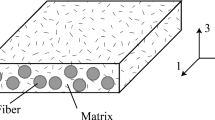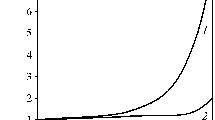Abstract
The response of structural components of high-strength cementitious (HSC) materials to projectile impact is characterized by high-rate fragmentation resulting from strong compressive shock waves coupled with reflected tensile waves. Accurate modeling of armor panels of such brittle materials under high-velocity projectile impact is a complex problem requiring meticulous experimental characterization of material properties. In a recent paper by the authors, an approach to handle such problems based on a modified Advanced Fundamental Concrete (AFC) constitutive model was developed. In the HSC panels considered in this study, an analogous approach is applied, and the predictions are verified with ballistic impact test data. Traditional Lagrangian finite element analysis (FEA) of these problems tends to introduce errors and suffers from convergence issues resulting from large deformations at free surfaces. Also, FEA cannot properly account for the issues of secondary impact of spalled fragments when multiple armor panels are used. Smoothed particle hydrodynamics (SPH) is considered to be an attractive alternative to resolve these and other issues. However, SPH-based quantitative results have been found to be less accurate than the FEA-based ones when the deformations are not sufficiently large. This paper primarily focuses on a comparison of FEA and SPH models to predict high-velocity projectile impact on single and stacked HSC panels. Results are compared to recent ballistic experiments performed as a part of this research, and conclusions are drawn based on the findings.

















Similar content being viewed by others
References
Nordendale N, Heard W, Ahn J, Basu P (2012) Mixed-dimensional and multi-scale modeling in computational mechanics. In: Proceedings of the 2012 Engineering Mechanics Institute Conference Notre Dame, TN
Zukas JA (2004) Introduction to hydrocodes. Studies in applied mechanics, vol 49. Elsevier, Amsterdam
Nordendale N, Heard W, Hickman M, Zhang B, Basu P (2013) Cementitious material models for simulating projectile impact effects. J Comput Mater Sci 79:745–758
Simulia (2014) Abaqus analysis user’s manual. Dassault Systemes, Providence
Zukas JA, Nicholas T, Swift HF, Greszczuk LB, Curran DR (1982) Impact dynamics. Wiley, New York
Gathers GR (1994) Selected topics in shock wave physics and equation of state modeling. World Scientific Publishing Co., Livermore
Chen W (1982) Plasticity in Reinforced Concrete. McGraw-Hill Book Co., New York
Reinhart W, Chhabildas L, Kipp M, Wilson L (1999) Spall strength measurement of concrete for varying aggregate sizes. In: 15th US Army Symposium, Myrtle Beach, SC
Johnson GR, Stryk RA, Beissel SR (1996) SPH for high velocity impact computations. Comput Methods in Appl Mech Eng 139(1–4):347–373
Mehra V, Sijoy CD, Mishra V, Chaturvedi S (2012) Tensile instability and artificial stresses in impact problems in SPH. J Phys Conf Ser 377:1–5
Willam KG, Warnke EP (1974) Constitutive model for the triaxial behavior of concrete. In: IABSE Seminar on Concrete Structure Subjected to Triaxial Stresses, Bergamo, Italy
Ottosen NS (1977) A failure criterion for concrete. J Eng Mech Div ASCE 103(EM4):527–535
Holmquist TJ, Johnson GR, Cook WH (1993) A computational constitutive model for concrete subjected to large strains, high strain rates, and high pressures. In: Proceedings of the 14th International Symposium on Ballistics, Quebec City, Canada
Tu Z, Lu Y (2009) Evaluation of typical concrete material models used in hydrocodes for high dynamic response simulations. Int J Impact Eng 36:132–146
Gebbeken N, Ruppert M (2000) A new material model for concrete in high-dynamic hydrocode simulations. Arch Appl Mech 70:463–478
Malvar LJ, Crawford JE, Wesevich JW (1997) A plasticity concrete material model for Dyna3D. Int J Impact Eng 19(9–10):847–873
Malvar LJ, Crawford JE, Morrill KB (2000) K&C concrete material model release III-automated generation of material model input. K&C Technical Report TR-99-24-B1, Glendale, CA
Riedel W (2000) Beton unter dynamischen Lasten Meso- und makromechanische Modelle und ihre Parameter. Doctoral Thesis, Institut Kurzzeitdynamik, Ernst-Mach-Institut, der Bundeswehr Munchen, Freiburg [in German]
Riedel W, Kawai N, Kondo K (2009) Numerical assessment for impact strength measurements in concrete materials. Int J Impact Eng 36:283–293
Tu Z, Lu Y (2010) Modifications of RHT material model for improved numerical simulation of dynamic response of concrete. Int J Impact Eng 37:1072–1082
Fossum AF, Brannon RM (2006) On a viscoplastic model for rocks with mechanism-dependent characteristic times. Acta Geotech 1:89–106
Frank A, Adley M (2007) On the importance of a three-invariant model for simulating the perforation of concrete slabs. In: Proceedings of 78th shock and vibration symposium. Philadelphia, PA
Polonco-Loria M, Hopperstad OS, Borvik T, Berstad T (2008) Numerical predictions of ballistic limits for concrete slabs using a modified version of the HJC concrete model. Int J Impact Eng 35:290–303
Beissel SR, Homquist TJ, Johnson GR (2012) Influence of the third invariant in the ballistic impact of silicon carbide. Int J Impact Eng 45:52–59
Adley M, Frank A, Danielson K, Akers S, O’Daniel J (2010) The advanced fundamental concrete (AFC) Model: Technical Report ERDC/GSL TR-10-51. U.S. Army Engineer Research and Development Center, Vicksburg, MS
Sherburn JA, Heard W, Park H, Chen W (2011) Modeling of the split Hopkinson pressure bar: application to cortuf. In: 82nd Shock and Vibration Symposium, Baltimore, MD
Sherburn JA, Hammons MI, Roth MJ (2014) Modeling finite thickness slab perforation using a coupled Eulerian-Lagrangian approach. Int J Solids Struct 51:4406–4413
Sherburn JA, Roth MJ, Chen JS, Hillman M (2015) Meshfree modeling of concrete slab perforation using a reproducing kernel particle impact and penetration formulation. Int J Impact Eng 86:96–110. doi:10.1016/j.ijimpeng.2015.07.009
Chen JS, Pan C, Wu CT, Liu WK (1996) Reproducing kernel particle methods for large deformation analysis of nonlinear structures. Comput Methods App Mech Eng 139:49–74
Schwer L (2007) Optional strain-rate forms for the Johnson Cook constitutive model and the role of the parameter Epsilon_01. In: 6th Eur LS-DYNA Users’ Conference Gothenburg, Sweden: ERAB
Huh H, Kang W (2002) Crash-worthiness assessment of thin-walled structures with the high-strength steel sheet. Int J Veh Des 30(1/2):1–21
Johnson GR, Cook WH (1983) A constitutive model and data for metals subjected to large strains, high strain rates and high temperature. In: Proceedings of 7th International Symposium on Ballistics. The Gague, Netherlands
Johnson GR, Cook WH (1985) Fracture characteristics of three metals subjected to various strain, strain rates, temperature and pressures. Eng Fract Mech 21(1):31–48
Acknowledgments
Permission to publish was granted by the Director, Geotechnical and Structures Laboratory. Simulations were partly performed on the Department of Defense Super Computing Resource high performance computers.
Author information
Authors and Affiliations
Corresponding author
Rights and permissions
About this article
Cite this article
Nordendale, N.A., Heard, W.F., Sherburn, J.A. et al. A comparison of finite element analysis to smooth particle hydrodynamics for application to projectile impact on cementitious material. Comp. Part. Mech. 3, 53–68 (2016). https://doi.org/10.1007/s40571-015-0092-1
Received:
Revised:
Accepted:
Published:
Issue Date:
DOI: https://doi.org/10.1007/s40571-015-0092-1




